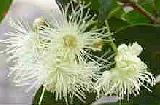|
[Front Page] [Features] [Departments] [Society Home] [Subscribe]

Lilly Pillys in the Garden
Caroline Haskard
The family Myrtaceae contains the genera Eucalyptus, Angophora and the new eucalypt group known as Corymbia (which are the bloodwoods and their close relations). What a lot of people don't realize is that there are many rainforest plants in this family group, in particular the Lilly Pillys. This common name is applicable to four different genera including: Acmena, Eugenia, Syzygium and Waterhousia. All botanical names come in two parts - the first is the genus and then the species name eg: Acmena smithii which, incidentally, has more than one common name. At least when we know the botanical name we all know what we are talking about.
Syzygium oleosum: Blue lilly pilly
This species, formerly known as Syzygium coolminianum, is found in rich and poor soils, most types of rainforest and moist open forests from Wollongong in New South Wales to the Atherton Tableland in north-east Queensland. The distribution notes are important because they tell you that this species is fairly adaptable, not only to soil type, but also to climatic vagaries. It is a medium tree capable of reaching 15 metres, with a tidy pyramidal shape, with dense foliage commonly retained to ground level.
 |
|
 |
|
Flowers and fruit of Syzygium oleosum
Photos: Geoff Keena
Click for larger image |
|
Flowers are cream to white with long "fluffy" stamens. They are carried in panicles in the upper leaf axils, and may appear any time from October to March - sometimes later. Fruits follow within a few months and may vary in colour from pink through to purple or blue, and mine are absolutely delicious. The quality of the fruit, like anything else, varies from tree to tree or in different locations, being variously described as crisp, juicy, delectable to resinous. Ours are so good that we are in direct competition with the wildlife, although there is generally enough to go around.
Our specimen was planted in April 1995 during the rather bad drought we had - into water-repellent soil (due to fungal hyphae). It was initially watered in and fertilized. After that it was basically on its own. In winter 1996 it was frosted when temperatures reached minus 5oC; we watered it and it has never looked back. Apart from the frost pruning, we have given it two light tip prunings - not because it needed it but because I was learning how to tip prune to create growth where I wanted it.
The mid-sized elliptical green leaves are loaded with oil dots and when crushed exude a lovely lemon scented aroma. Peeled seed is said to germinate in 1-2 months, but mine have germinated within a few days.
This is a beautiful small tree all year round with the gorgeous flowers and pretty fruits as an added bonus, loved not only by us but the birds too. Currently this tree is about 4 m high and 2.5 m wide which I consider good when its hard life is taken into consideration.
Acmena smithii: Lilly pilly
Formerly known as Eugenia smithii, this species is found in all types of rainforest from southern Victoria to Bundaberg in Queensland, from the seaside (littoral rainforest) to the mountains (montane rainforest). The broad-ranging habitats not only suggest an adaptable plant but have resulted in three distinct forms which differ in leaf size and shape, and in the size of the plant which may range from a bushy shrub through to a tree of 20 metres.
Like its relatives (or most of them) it has dense, lustrous foliage which is also retained to near ground level. Despite the leaves containing oil dots there is no discernible aroma if crushed.
Flowers are creamish/white and fluffy, borne in terminal panicles, appearing from November to January. These are followed some months later by small (1 cm or less) fruit which may be white, green, pink or mauve. The flesh surrounding the inner seed is edible, but is generally insipid and preferred by ants; so break the fruit open before biting into it.
This lilly pilty has been popular for many years as a tough, reliable plant which always looks good. I can attest to this, as ours only gets watered when it rains - which for the last 6-7 months has hardly happened at all. Long-horned grasshoppers love chewing the tips off this plant which only makes it grow bushier and produce more of its lovely shiny red new growth. Extra water and fertilizer will not only make it grow quicker but promote regular flushes of new growth also. It has been stated that this species is remarkably resistant to fire - for a rainforest plant,
Ours is planted on a gully so is fairly sheltered, but there are several around Kingaroy which attest to its frost hardiness. Wrigley and Fagg in their book Australian Native Plants state that it has been tested to -7 degrees C.
At this stage our tree is too young to produce flowers or fruit, but last year I collected some fruit from a friend's garden, peeled them and threw them at the base of our tree and covered them with a little leaf mould. Germination began after about five weeks, at which time all seedlings were potted up and are doing nicely.
This species is recommended to those who want a tough plant which is suitable either as a specimen or as a screen-windbreak. It can be a little slow in its growth, but, as previously mentioned, extra water and fertilizer soon cure this problem.
Waterhousia floribunda: Weeping lilly pilly
This plant was formerly known as Syzygium floribundum and is not recommended for your average suburban block as it can reach a height of 30 metres with a spreading crown up to 10 metres or more wide. It is always found growing (naturally) below 600 metres in altitude from about Newcastle in New South Wales to Mackay in north Queensland, along stream or river banks where its graceful, pendulous foliage shades the water - often a watercourse is completely closed in by the canopies of this beautiful species.
The long leaves with their wavy margins are a dark glossy green with new growth sometimes vivid red before turning lime green Occasional old leaves turn red before dropping. In low light areas the lime green new growth against the glossy dark green older foliage looks stunning,. This, coupled with its lovely shape and attractive weeping habit, has made it well known in cultivation for many years.
The white flowers are very tiny (about 2 mm) but are borne in large terminal panicles which stand out nicely against the leaves, from about October to January, The greenish-white berries are also quite small - generally less than 1 cm and are crowned with a persistent calyx rim. They can usually be found on the tree about six months after flowering and always look immature, which makes it difficult for seed collection. Fresh fallen fruits would be ideal. However, the wildlife has often beaten you. The fruit is not poisonous, but certainly could not be described as edible.
Coming from sheltered sites, this tree is much hardier than expected being quite happy in full sun and able to withstand at least a light frost. It is reputed to like large quantities of water, but at our place is surviving quite well with none. The only drawback has been retarded growth. If treated to additional water and fertilizer you may be rewarded with very fast growth. About the only thing this species objects to is poor drainage, and l would recommend it to anyone with a creek, dam or gully and the room to grow it.
Seed will germinate within 3-6 weeks as a general rule. Psyllid insects love the newer growth and often cause pimpling of the leaves, which some would consider to be unsightly, but which I think adds to the interest. It is often a common problem with young lilly pillys of all types, but usually disappears (or becomes unnoticeable) in older specimens.
From the newsletter of the Kingaroy Branch of the Society for Growing Australian Plants (Queensland), March 2000 (via SGAP Queensland's "Bulletin").

[Front Page] [Features] [Departments] [Society Home] [Subscribe]
Australian Plants online - June 2003
Association of Societies for Growing Australian Plants
|